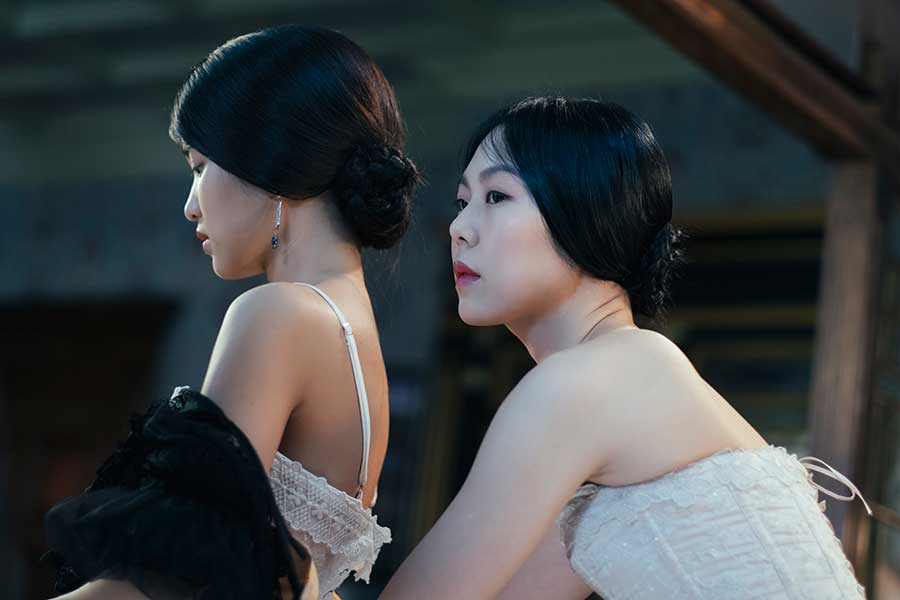“The Handmaiden,” opening Nov. 4 at the Ritz Five, is Korean filmmaker Park Chan-wook’s spellbinding adaptation of lesbian author Sarah Waters’ celebrated Victorian-era novel, “The Fingersmith.”
Set in 1930s Japan-occupied Korea, the film opens with Sook-hee (Kim Tae-ri) narrating her experiences working as a handmaiden for Lady Hideko (Kim Min-hee), a Japanese woman with a large inheritance who is living in a grand mansion with her Korean uncle Kouzuki (Cho Jin-woong), a book enthusiast.
Sook-hee first meets Hideko when the latter cries out in the middle of the night. Sook-hee is “flummoxed” by Hideko’s beauty, and soothes her mistress with a spoonful of sake and a song. However, it is soon revealed that Sook-hee is a pickpocket who has been primed by Count Fujiwara (Ha Jung-woo), a con artist, to help him seduce Hideko and abscond with her fortune. (And it is no spoiler to disclose that Fujiwara is not a real count.)
Part One of “The Handmaiden” shows how Sook-hee goes about her secret plan: When Hideko complains during a bath that her tooth aches, Sook-hee uses her finger to smooth away the pain. It is an erotic moment that leads to another seductive act during which the Lady and her handmaiden play dress-up (and undress) together. Later, when the two women are sharing a bed together, Hideko asks Sook-hee to help her practice kissing as the Lady worries she may be unprepared for marital relations with her betrothed, the count. The women’s erotic and enthusiastic passions in bed that night suggest Sook-hee is a very apt teacher and Hideko is a “natural” when it comes to lovemaking.
Soon the two women are stealing kisses as the count conspires to steal Hideko’s riches. Yet even as this unfolds in the first hour of “The Handmaiden,” this revenge drama is only just getting started. After a double-cross is revealed at the end of Part One, the film shifts its narrative from Sook-hee’s point of view to Hideko’s. Part Two focuses on the Lady’s story and recounts her point of view on the scenes that Sook-hee has narrated. Viewers will recalibrate what they think they know based on what they have seen, and it would spoil the film’s many pleasures to disclose too much about the narrative twists.
What can be revealed is that Hideko was orphaned and sent to live with her Uncle Kouzuki, who runs a literary salon. It turns out this is an erotic-literary salon where she reads lurid S&M stories to her uncle’s male friends. There are even a few scenes of her acting out some of the spankings recounted in the tales. Park stylishly realizes these episodes, and if they feel gratuitous, they nevertheless inform Hideko’s attitudes towards both men and sexuality. Hideko indicates that she may be a pawn for men because she is rich and beautiful, and a woman, but she also suggests she is no fool. Her cunning and manipulation make her a kindred spirit to Sook-hee. The question is, will the deception between the Lady and her handmaiden be someone’s undoing?
Park answers with a resounding yes and has a few tricks up his sleeve as “The Handmaiden” unfolds. The story may involve deception and double-crosses, but it also features cross-dressing, voyeurism, poisoning, murder and blackmail. There are even a few brief scenes of torture that are not part of the S&M practices detailed in the erotic stories, but an act of revenge that is as warranted as it is painful. That Park makes this sequence both beautiful and bloody is a testament to his masterful qualities as a filmmaker, but may be troublesome for the squeamish.
What is at the heart of “The Handmaiden” is not just a highly satisfying story of characters experiencing several reversals of fortune, but also a commentary on the roles of women in 1930s Korea (and, by extension, the Victorian era depicted in the novel). The film shows how women of the era are prized for their beauty and wealth, and less-valued for their thoughts and emotions. But Sook-hee and Hideko notably show what happens when women are in control over their sexuality.
Park films “The Handmaiden” in rich, vivid colors, and the ornate interiors and luscious exterior make the film visually breathtaking. A shot that merges smoke and a glass of wine is especially gorgeous. The director’s roving camera creates real emotion as Park frames his characters behind a screen, under a canopy of trees, looking through a peephole or from overhead. Moreover, his emphasis on sensuality permeates much of the film — from the naughty stories to the lengthy, intimate sex scenes between the women that suggest they may have more affection for one another than anyone realizes.
The final reveal in “The Handmaiden” may not surprise queer viewers, but like the film, it is still immensely gratifying.
